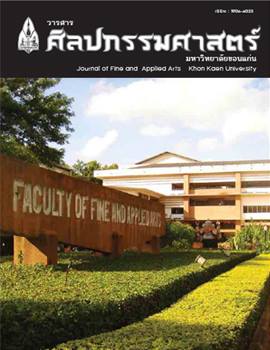การศึกษาปี่แต้ เครื่องเป่าวงมโหรีพื้นบ้านอีสานใต้ จังหวัดสุรินทร์
Main Article Content
Abstract
This study is conducted according to ethnomusicological medthodology through collecting information in the field . The purpose of this study is two-fold:
(1) First, it aims to investigate the background and component of Pee Tae at Nonjarn Village, Tambol Tael, Amphoe Sikhoraphum, Surin Province;
(2) to analyze Pee tae songs at Nonjarn Village Tambol Tael, Amphoe Sikhoraphum, Surin Province.
The results reveals that Pee Tae is a kind of local oboe, this blown instrument in similar to Thai central region’ flute but smaller. In the former time, Pee Tae is used as a conductor of local south Isan orchestra. This study investigates Pee Tae playing by Mr. Boue Saleepim who is 74 years old. He is in a villager in Nonjarn Village, Tambol Tael, Amphoe Sikhoraphum, Surin Province. Mahoree- Pheanban is consisting of many local musical instruments with the core instruments are Pee Tae, Klong nung yai ( folk drum), and Thai folk fiddle with small cup -shaped cymbals and cymbals as punctuating instrument. Pee Tae can be played in Mahoree- Pheanban band and in a parade. Musicions perform homage ceremony to teacher’s song, called “Suey Ha” before playing the music and they played the first song is Chin song. They could earn much money when they are proposed to play in many occasions in the past time, but very rare nowadays.
There are few inheritance of local music with Pee Tae because now there are scarcely musicians. We can see other musical instruments as local culture succeeds to young generation except Pee Tae.
The songs played with Pee Tae include 3 types as 1) homage ceremony to teachers’s song, 2) general playing’s song, and 3) playing in parade’ s song, which were simple, use G scale. The music melody will alternately move with variety of melodies and unique rhythmic pattern in each songs. In each interval, there are atonal music of melody according to the scales. In addition, there was a secondary tones intervened resulting resonances which indicate the unique local music of Khmer resonance.Article Details
Content and information in articles published in the Journal of Fine and Applied Arts of Khon Kaen University is regarded as the opinion and sole responsibility of the author(s) directly; therefore, editors are not obliged to agree to or share any responsibility with regard to the content and information that appears within these articles.
All articles, information, content, image, etc. that have been published in the Journal of Fine and Applied Arts of Khon Kaen University is the copyright of the Journal of Fine and Appllied Arts of Khon Kaen University. Any person or organization who wishes to distribute all or parts of the articles for further dissemination or other usage must first receive permission from the Journal of Fine and Applied Arts of Khon Kaen University before proceeding to do so.


